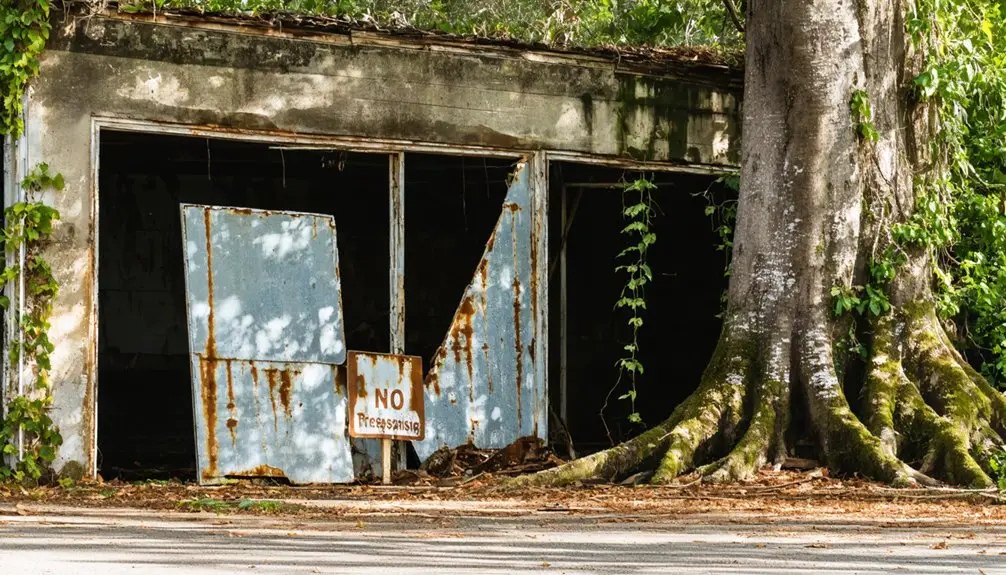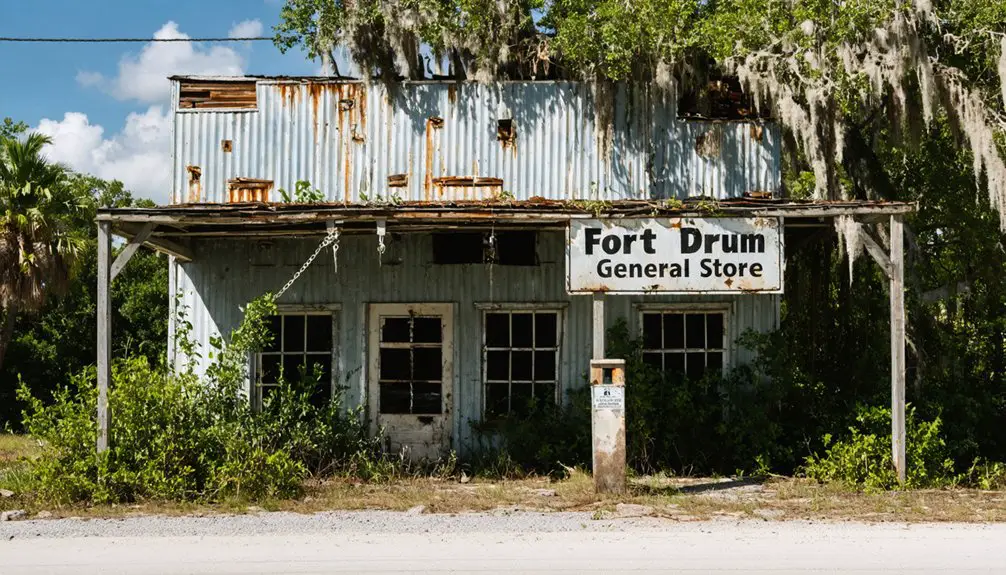You’ll find Fort Drum’s ghost town remains along US 441 in Okeechobee County, Florida, where an eight-acre pioneer cemetery marks the site of a once-thriving military outpost. Established in 1842 as a strategic military point, the settlement grew with pioneer families and later flourished when the Florida East Coast Railway arrived in 1914. Today, while the original structures are gone, the cemetery and surrounding 21,000-acre wildlife management area preserve Fort Drum’s fascinating frontier legacy.
Key Takeaways
- Fort Drum was established in 1842 as a military outpost and later became a pioneer settlement with trading posts and agricultural activities.
- The town experienced growth after the Florida East Coast Railway reached it in 1914, establishing a key depot and commerce hub.
- Complete abandonment led to Fort Drum becoming a ghost town, with only an eight-acre cemetery remaining as evidence of past settlement.
- The site is located at coordinates 27.5264°N, 80.8069°W along US 441, with no standing structures or visible ruins remaining.
- The surrounding area now features a 21,000-acre wildlife management area and the Fort Drum Marsh Conservation Area.
The Military Origins and Strategic Importance
Following the Second Seminole War in 1842, Fort Drum emerged as an essential military outpost within the US Army’s network of frontier forts across central Florida.
You’ll find Fort Drum’s military strategy centered on its prime location at the intersection of two significant military roads. The east-west route connected Fort Bassinger to Fort Vinton, while the north-south “old wire road” linked Fort Kissimmee to Fort Jupiter. The 10th Mountain Division trained soldiers here during crucial wartime operations.
This strategic positioning enabled rapid troop movements and supply chain efficiency for frontier defense operations. Like Madison Barracks, Fort Drum was designed to provide optimal training conditions for military personnel.
Though US Army soldiers only briefly garrisoned the fort, its establishment played an important role in protecting settlers and securing communication lines.
Fort Drum’s placement helped control valuable cattle and agricultural lands while forming part of a defensive chain that monitored Florida’s interior, ultimately paving the way for civilian settlement after the Civil War.
Early Pioneer Settlement and Development
As the military presence at Fort Drum waned in the post-Second Seminole War era, pioneer settlers began establishing roots in the promising cattle country during the 1870s.
You’ll find that early pioneers like Joel Swain, Henry Parker, and Henry Holmes were among the first to recognize the area’s potential.
Parker, who’d moved from Bartow to Bluff Hammock, sold his claim at Fort Bassinger to Rabon Raulerson before settling in Fort Drum. He established a trading post that became essential to both settlers and local Seminole Indians. The trading post primarily dealt in hides and plumes from local Seminole hunters.
Despite pioneer challenges like isolation and limited supplies, the settlement persisted. The marshlands near St. Johns Marsh and various creeks proved ideal for cattle grazing, though settlers had to contend with forest fires and harsh environmental conditions. The area’s elevation of 590 feet provided natural drainage for livestock pastures.
Through hardship and scarcity, pioneers endured, finding fertile grazing land amid marshes while battling nature’s constant challenges.
Economic trade centered around basic supplies, agricultural tools, and livestock needs.
Railroad Arrival and Community Growth
The late 19th century brought transformative change to Fort Drum’s pioneer landscape through Henry Flagler’s ambitious Florida East Coast Railway expansion.
By 1914, you’d find the Kissimmee Valley Extension reaching Fort Drum, establishing an essential depot that connected this once-isolated cattle country to Florida’s broader economic networks. Through land grants and acquisitions, Flagler’s company claimed over two million acres across Florida to enable railway development.
You’ll see how railroad expansion revolutionized the area’s prospects. The economic impact was substantial – cattle ranchers could now easily ship their livestock to market, while Flagler’s land grants spurred real estate development and settlement.
The depot’s presence attracted businesses and services, transforming Fort Drum into a bustling hub. With improved transportation and communication links, the community flourished as part of a growing corridor that connected rural settlements to coastal cities, forever changing the region’s economic possibilities. Like Flagler’s other railway projects, Fort Drum’s development was funded through private investment funds, demonstrating his commitment to Florida’s growth without government assistance.
Natural Heritage and Fossil Discoveries
While Fort Drum’s pioneering history shaped its early development, its natural heritage remains equally compelling through the Fort Drum Marsh Conservation Area‘s diverse ecosystems.
You’ll find a rich tapestry of wetlands, dry prairie, pine flatwoods, and hardwood swamps, featuring cypress, cedar, and sabal palms along the blackwater boardwalk trail. As the southernmost reach of the St. Johns River headwaters, it’s a vital site for regional water dynamics. Near these trails, the historic Fort Drum Cemetery contains 381 internments dating back to 1876. Wildlife enthusiasts can spot diverse native species including Florida sandhill cranes, wood storks, and bald eagles throughout the property.
At the Fort Drum Crystal Mine, you can uncover remarkable fossils that tell an ancient story.
Using mechanical diggers and washing tables, you’ll discover fossilized clams, coral, calcite, and even squid tentacles. These marine fossils reveal that this area was once submerged beneath prehistoric seas, offering a fascinating glimpse into Florida’s geological past and making Fort Drum a significant site for amateur paleontologists.
Historical Cemetery and Cultural Legacy
Nestled in the heart of Fort Drum’s abandoned townsite, an 8-acre historical cemetery serves as the last major physical remnant of this once-thriving pioneer settlement.
You’ll find 381 internments here, dating from 1876 to present, including graves of the area’s earliest settlers and Seminole Indians who traded with them.
The cemetery’s symbolism extends beyond its role as a burial ground – it’s a reflection of the perseverance of Fort Drum’s pioneering spirit.
Like the historic POW Cemetery at Fort Drum, New York, this site holds solemn memories of those who shaped the region’s history.
The wooded surroundings create a peaceful atmosphere for visitors exploring this historic site.
You can visit from dawn to dusk to explore the headstones that tell stories of frontier life, cultural interactions, and community formation.
Preservation efforts by Okeechobee County guarantee this crucial historical link remains intact, maintaining the site for descendants, historians, and visitors seeking to connect with Florida’s frontier heritage.
The Decline and Abandonment
Originally established as a U.S. Army post in 1849, Fort Drum’s decline began almost immediately with its deactivation in 1850.
Though briefly reoccupied in 1856, the fort’s permanent abandonment in 1861 during the Civil War marked the beginning of its transformation into a ghost town.
You’ll find that while settlers arrived in the 1870s to establish cattle ranches, and Henry Parker opened trading posts, the area never achieved substantial growth.
Even the 1914 addition of the Florida East Coast Railroad’s depot couldn’t prevent economic stagnation.
The lack of infrastructure development and limited transportation options triggered population migration away from Fort Drum.
Despite its strategic location at the intersection of two military roads, the community failed to diversify its economy beyond basic commerce and ranching, ultimately leading to its complete abandonment.
Modern-Day Ghost Town Status

Today’s Fort Drum stands as a tribute to its complete transformation into a ghost town, with only an eight-acre cemetery remaining as evidence of its past settlement.
Fort Drum’s ghostly presence echoes through time, marked only by its eight-acre cemetery, a solitary witness to history.
For urban exploration enthusiasts, you’ll find no standing structures or visible ruins from the original fort or town, though the site’s coordinates (27.5264°N, 80.8069°W) will lead you to its location along US 441.
The area’s historical preservation now focuses solely on the cemetery, maintained by Okeechobee County.
What you’ll discover instead is a sprawling 21,000-acre wildlife management area and the flooded remains of Ruck’s Pit quarry.
While the original settlement has vanished, the site’s legacy lives on through its name, which graces a Florida Turnpike service plaza and the surrounding conservation lands.
Frequently Asked Questions
Are There Any Ghost Stories or Paranormal Activities Reported at Fort Drum?
You won’t find documented ghost sightings or paranormal encounters at this location. Historical records don’t mention supernatural activity, and unlike other Florida ghost towns, there aren’t any well-known haunting reports.
What Happened to the Original Fort’s Equipment and Military Supplies?
You won’t find much trace of the original military inventory, as Fort Drum’s supply disposal happened gradually. Equipment was either redistributed to other bases or scrapped according to standard military procedures.
Did Any Famous Historical Figures Ever Visit Fort Drum?
You won’t find any famous historical figures among Fort Drum’s notable visitors. Despite its historical significance as a military crossroads, records show only local pioneers and soldiers occupied the fort during its operation.
What Was the Peak Population of Fort Drum During Its Heyday?
You’ll find that peak demographics suggest a modest population in the low hundreds during Fort Drum’s heyday, though exact figures aren’t documented. The town experienced steady population decline until becoming abandoned.
Are Metal Detecting or Archaeological Activities Permitted at the Site Today?
While you might want to explore freely, you can’t metal detect or dig here without permits. Archaeological preservation regulations require explicit permission from Okeechobee County authorities for any site investigation or artifact recovery.
References
- https://en.wikipedia.org/wiki/Fort_Drum
- https://sites.rootsweb.com/~flokeech/newspaper/historyoldftdrum.html
- https://fortwiki.com/Fort_Drum_(3)
- https://www.ghosttowns.com/states/fl/fortdrum.html
- https://www.legendsofamerica.com/more-florida-forts/
- https://home.army.mil/drum/about/history
- https://history.army.mil/Army-Museum-Enterprise/Find-an-Army-Museum/10th-Mountain-Division-and-Fort-Drum-Museum/
- https://www.lakeontariorealty.com/default.asp.pg-FortDrum
- https://www.lamartin.com/history/history_of_okeechobee_county/chapter3.htm
- https://dlab.epfl.ch/wikispeedia/wpcd/wp/f/Florida_East_Coast_Railway.htm



